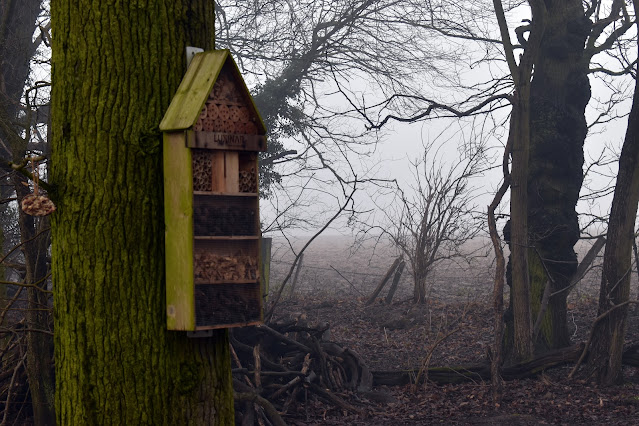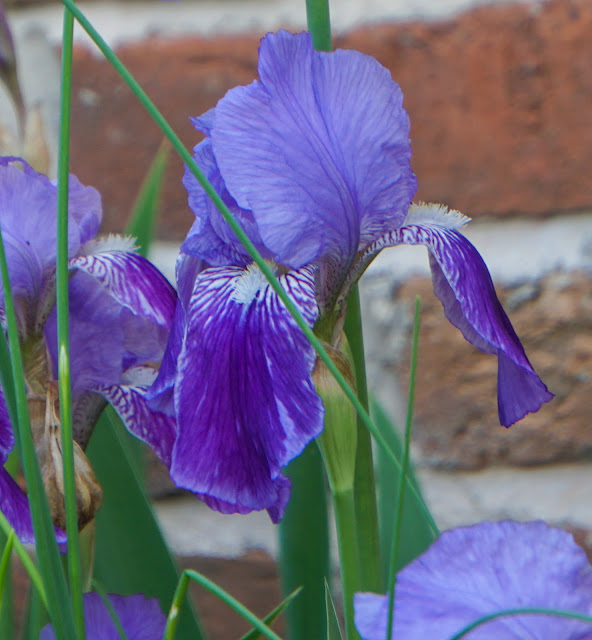 |
| Insect Hotel |
Bug hotels or Insect Houses are an essential item in our garden. They are a feature in themselves and are a vital component of our wildlife-friendly garden.Insect Hotels can be bought or handmade and are both equally effective. When you have a bug house you are aiming to attract all manner of insects and wildlife to gain a balance of insects in your garden which is vital if you are aiming to have a harmonious wildlife garden.
Insect Hotels Benefits To The Garden
Having an Insect Hotel in the garden is not entirely altruistic. The aim of any wildlife gardener is to use no pesticides, fungicides, or herbicides at all.
These chemicals kill "pests" and beneficial insects equally in most cases and are not good for wildlife.
For the gardener, an insect hotel can attract all manner of bugs and many predators that will help us to keep a good balance in the garden thus eliminating the need to use pesticides.
 |
| Bee on Daffodil |
In the early days of converting a normal garden to a wildlife pesticide-free garden, this can take some nerve. A garden needs a natural balance of predator and prey.
If you or a previous garden have been using chemicals then stop, undoubtedly in the first year or so you will see greenfly and blackfly and all manner of pests eating our plants. This is because your garden became unbalanced. It is now for us to redress this balance and installing insect houses is one easy step.
However, if we want a wildlife friendly garden we must resist the urge to use chemicals. Instead, we must attract the beneficial insects, spiders and predators to our gardens who will easily and quickly dispatch those pests eating our plants.
A great way to do this especially in the early days is to have an Insect Hotel or several bughouses. Provide insects shelter and a food source and they will arrive.
 |
| Insect Hotel In Garden |
Personally in the first two years of taking on this garden, I simply did not grow plants I knew would be susceptible to aphid attack. The previous gardeners had used chemicals and had a very non-wildlife friendly garden, so I knew once I stopped all chemical use I would face some difficulties.
It took a year or two to fully balance the garden again. I was lucky as my neighbours also stopped using chemicals which helps a lot as wildlife do not know about boundaries. It was so worth it as since then I have not had to spend any money on insect prevention, the predators do it all for me free of charge night and day!
In this article, we will mainly talk about insect houses with a mention and further resources to our ground-dwelling beneficial creatures need as well.
Location Of an Insect Hotel.
A Bughouse or Insect Hotel is best located in a warm undisturbed spot in your garden. For insects, it is important it is in a fairly dry area so under the house or shed eaves, in a tree or against a sunny fence.
Some may be a thing of beauty or they may be something you wish to hide from full view. Either way, it does not matter to the bugs as long as they can go about their business undisturbed. We like the look of ours so we do not make any particular effort to hide them.
Who Lives in an Insect Hotel?
 |
| Close Up Of Insect Hotel |
So what can you expect to live in your insect hotel?Generally, you can expect a variety of insects such as ladybirds and woodlice. You will get spiders of course and hopefully bees or maybe wasps.
These are all beneficial creatures to your garden. These creatures need a place to shelter, raise their young and keep themselves and their young hidden from predators.
You can of course just put up your insect hotel and forget about it, but It can be good fun to carefully observe your insect hotel to see who has taken up residence.
Types of Wildlife Hotels.
It is better to have several insect-specific bughouses around the garden in suitable locations than one great big multi-bug house.
The idea is that each will be more suitable for one species than another. Of course, there is no way of knowing who will decide to take up residence!
The rationale is that different species require different approaches. For example, a home to attract bees requires a warm sunny dry location. Ideally, it should face south or as near south as possible and the area in front of it would be clear of vegetation. It is important to be a few feet off the ground and secured strongly to a wall, tree or fence. You can buy Bug Houses that hang up with wire or string, some that need nailing up an other Insect Houses with Stakes that can be put into the ground. Ideally a variety of these in the garden is best.
 |
| Insect Hotel In The Woods |
Spiders are happy in a site with more cover where they can spin webs between tree branches and the insect hotel but in my experience, they are not too fussy.
In addition, while you are siting your bug houses spare a thought for ground dwelling creatures like hedgehogs who are also very beneficial to our gardens.
Hedgehogs are a species in serious decline. A lovely pile of wood and leaves in an undisturbed corner of the garden will go a long way towards helping these enchanting and ancient creatures. If you would like to take it a step further you can purchase a special house for them known as a Hogitat. Please read more about How To Help Hedgehogs In Your Garden
 |
| Well Established Wood Pile |
If you are wanting to attract frogs and toads they will love a warm wet, damp environment in a shady spot down on the ground.
You can start a wildlife hotel at any time though you may be more successful if you put one up in early Spring or Autumn/Fall.
Materials For An Insect, Bee Or Spider Hotel.
Ideally, you will have a bug house made of natural materials. The wood is best untreated with no paint or preservatives as that will only deter and harm insects.
 |
| Wooden tubes for insects in Bug House |
If you are making your own do try to use items already in your garden to promote recycling within the garden. So small branches, hollow stems tied together, dried leaves, seed heads will all contribute to your insect hotel. The structure needs to be strong and solid with a sloping and wide roof to keep the rain out.
If you are buying a bug house with pre-drilled holes in the wood they should be smooth and if doing it yourself make sure there are no splinters.
Think about the types of creatures or insects you want to attract and the habitat they require.
 |
| Wood shavings for insects in bug hotel |
Looking After An Insect Hotel.
You can expect an insect hotel to last about 2 years on average, maybe longer depending on the materials used. As it is made of natural material it will degrade over time.
During this time it is recommended to clean it out at the end of each summer to remove any dead cells or insects and replace any worn-out sections. That is all that is really needed.
Insect Houses Are A Learning Opportunity For Children
Bug houses are a great learning experience. It is also a wonderful fun and educational opportunity for children to learn about and appreciate the natural world.
In a small wood near a busy residential area, primary school children have made insect houses to site all over the wood to help the local wildlife and they take great pride in their creations and interest in the inhabitants.
 |
| Bug Hotel In The Woods Good For Winter Shelter |
In our garden, we have a dry insect house 3 feet off the ground on a sunny fence, a log pile in a shady but warm corner to attract hedgehogs and in a corner near the garage a large saucer of water with dense habitat around it to attract frogs and toads. The spiders seem to make their home in many of these locations as well.
Having a bug hotel or two and making a habitat for wildlife is very enriching in our gardens and our lives.
Insect houses take up very little room, so most people could have an insect house in an outdoor space. The end result of all this care is a garden that is filled with the sound and sights of beautiful insects.
Yes, we do still get greenfly and blackfly, but predator insects soon become aware of them and keep the numbers down or even eradicate them for me. We do perhaps have to accept some level of pest attack on our plants but when you achieve that crucial balance it becomes less of a problem.
I am certainly prepared to have some plant damage to know that I am not killing all insects indiscriminately. Chemicals kill both "pests" and beneficial insects.
I once had a houseplant that became invested with a type of whitefly, so as it was summer I put it outside during the day for a few days and the wasps ate all the flies for me and the plant survived.
Other insects like this gorgeous butterfly happily live in the garden now going about their daily lives and bring me a lot of joy.
 |
| Beautiful Butterfly In Summer |
People often think about the beautiful more visible wildlife like birds, but it all really begins with the small perhaps less beautiful or more scary insects. If we take more care of them they will help our gardens be more healthy and we will certainly see more birds and other gorgeous wildlife as well.
Without our negative influence of chemicals, over time the garden adopts an easy give and take, ebb and flow of natural processes and our plants and us benefit from that.
There are many useful and fun things you can do for wildlife in our own garden spaces, having a few insect hotels is a great start.
More Wildlife And Gardening Articles
6 Ways To Help Wildlife In The Year Ahead
Spring Woodland Walks For Wellbeing Reviewed
Wildlife Gift Ideas Reviewed
Diary Of A Wild Country Garden
Essential Wildlife Gardening Gifts
Gardening And Wildlife Articles On Review This Reviews
Note: The author may receive a commission from purchases made using links found in this article. “As an Amazon Associate, Ebay (EPN), Esty (Awin), and/or Zazzle Affiliate, I (we) earn from qualifying purchases.”
























































